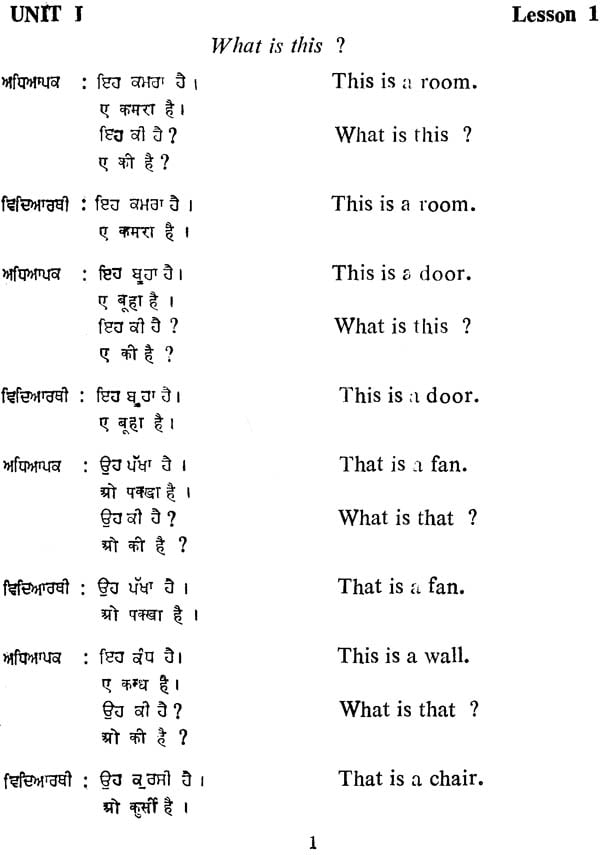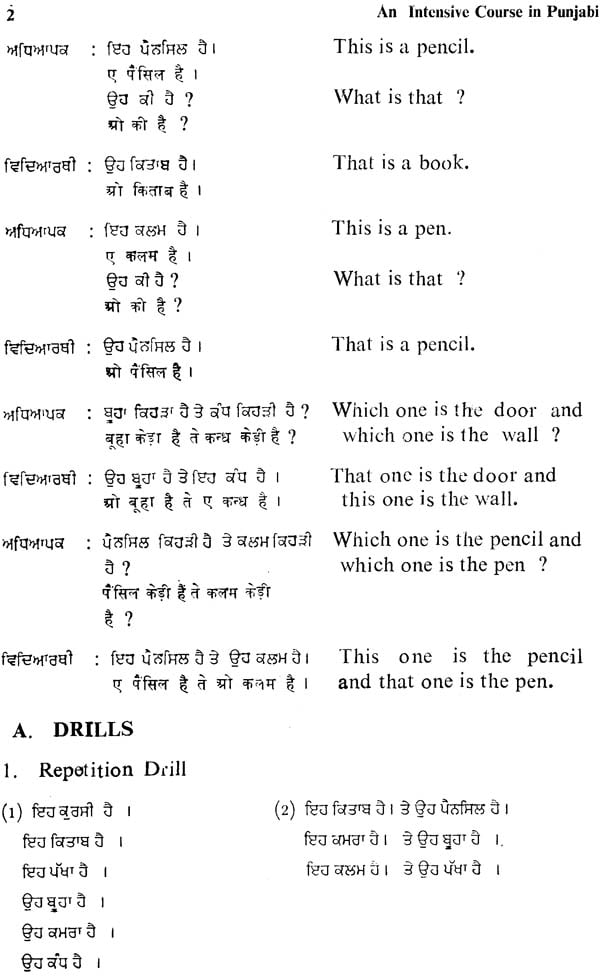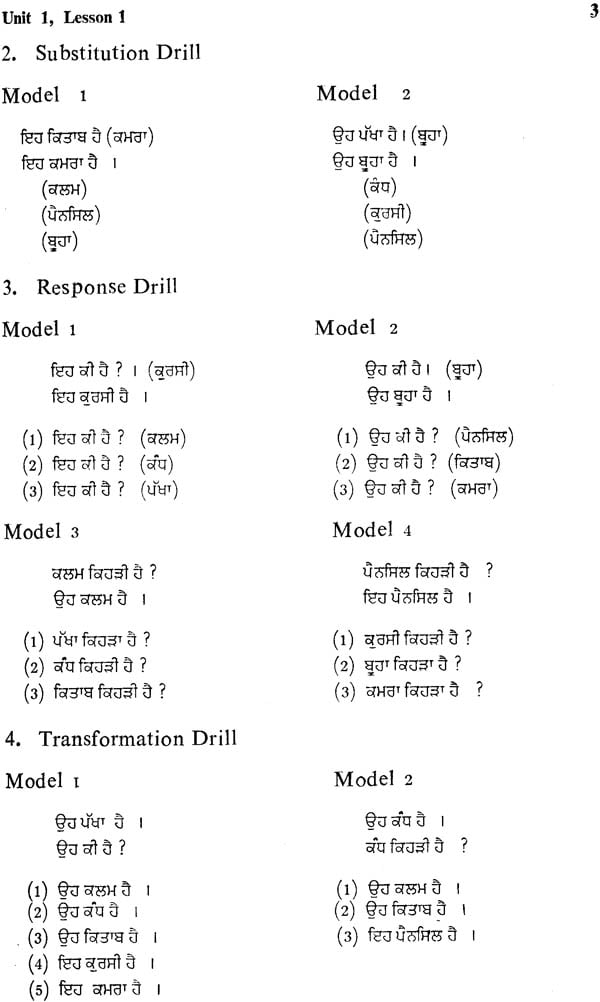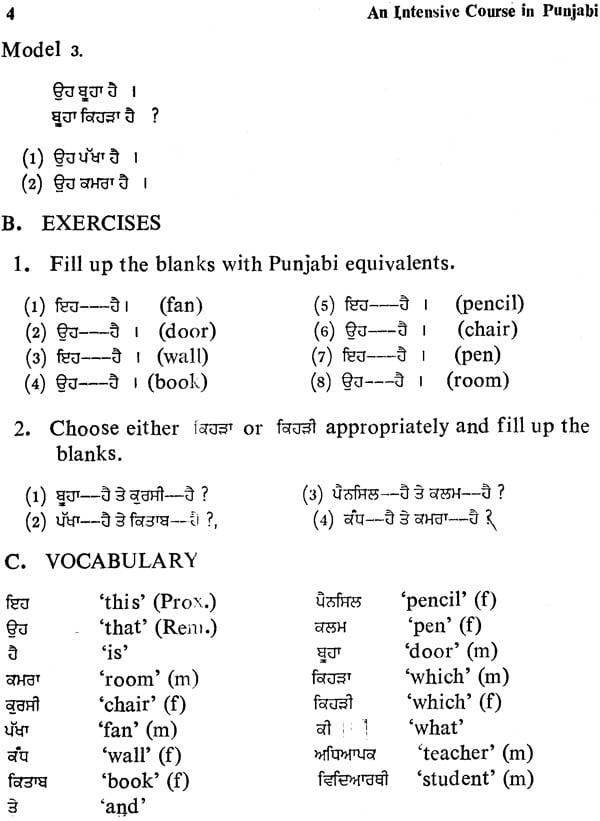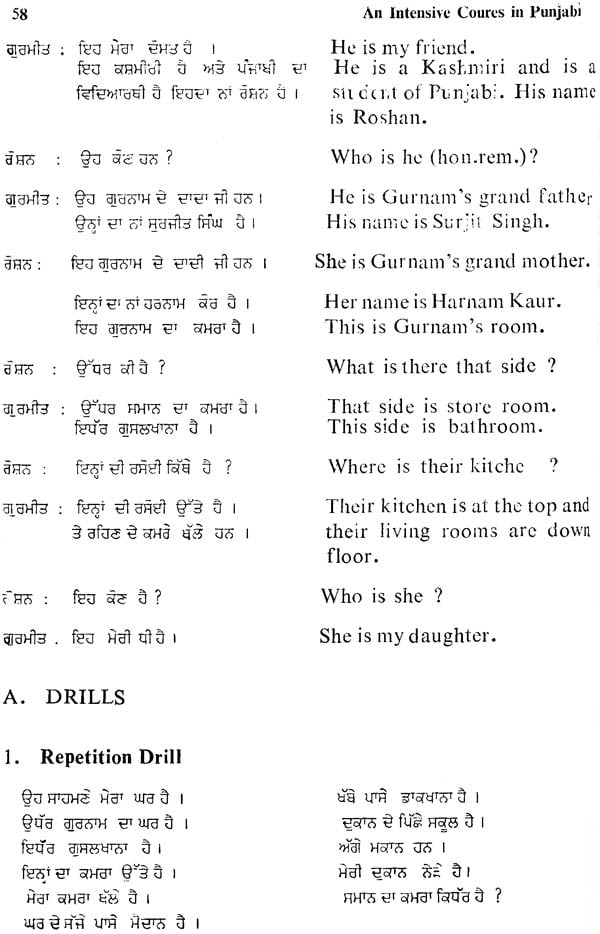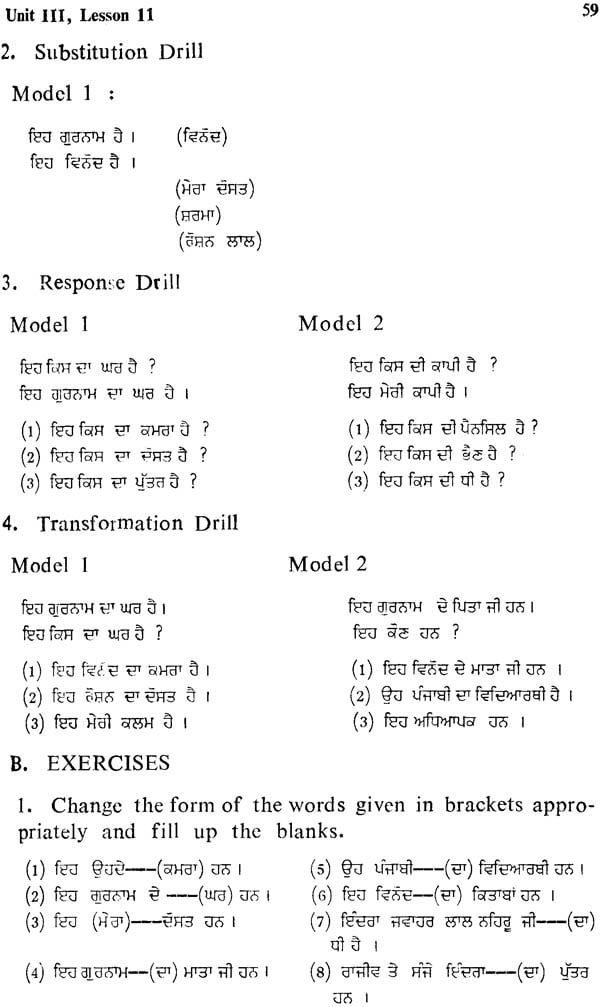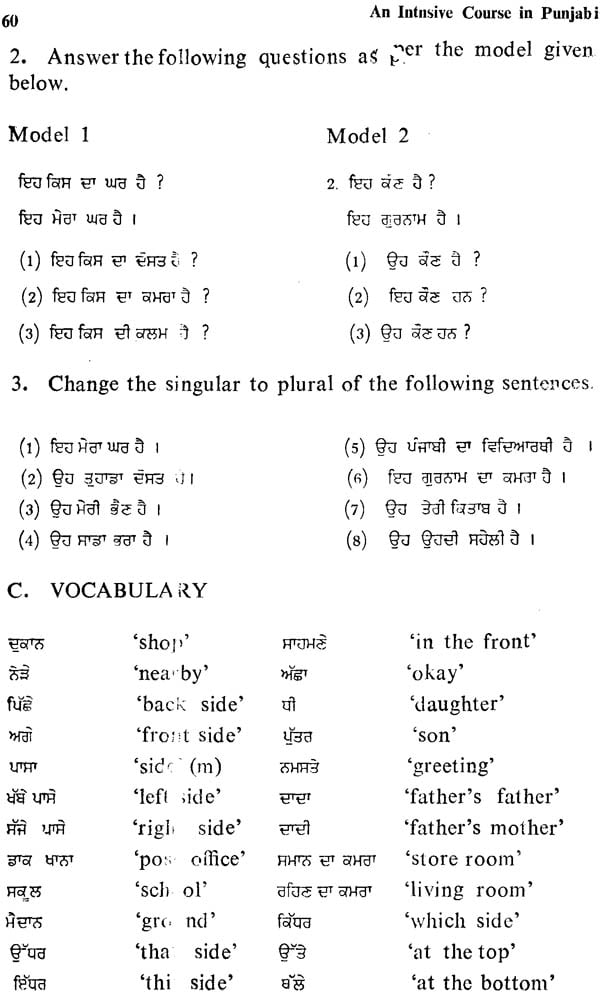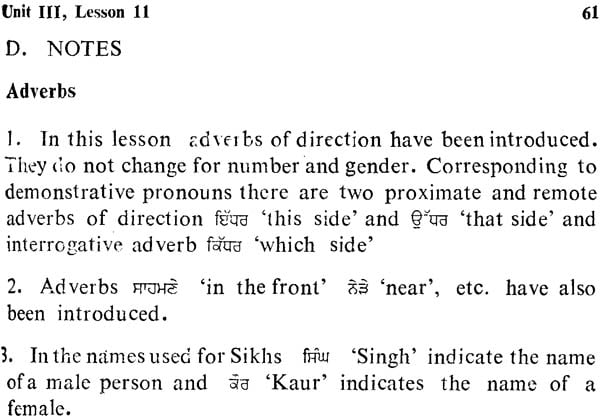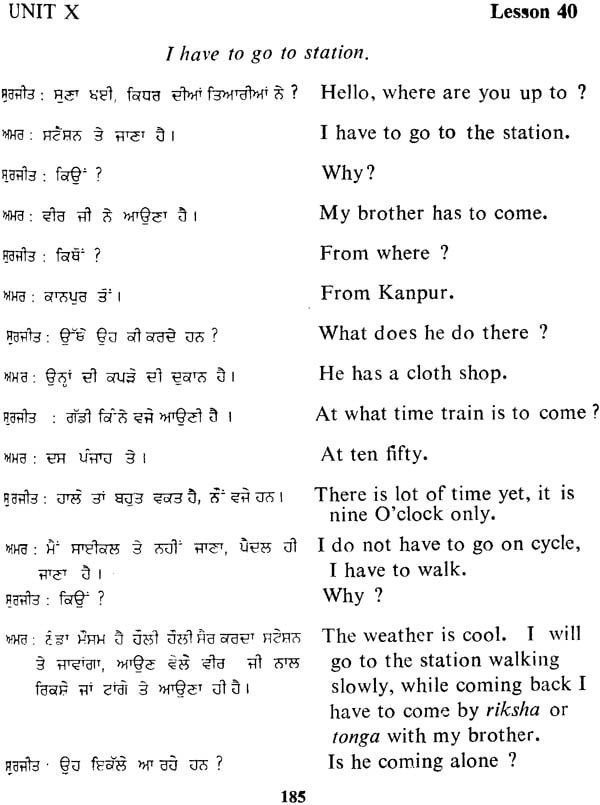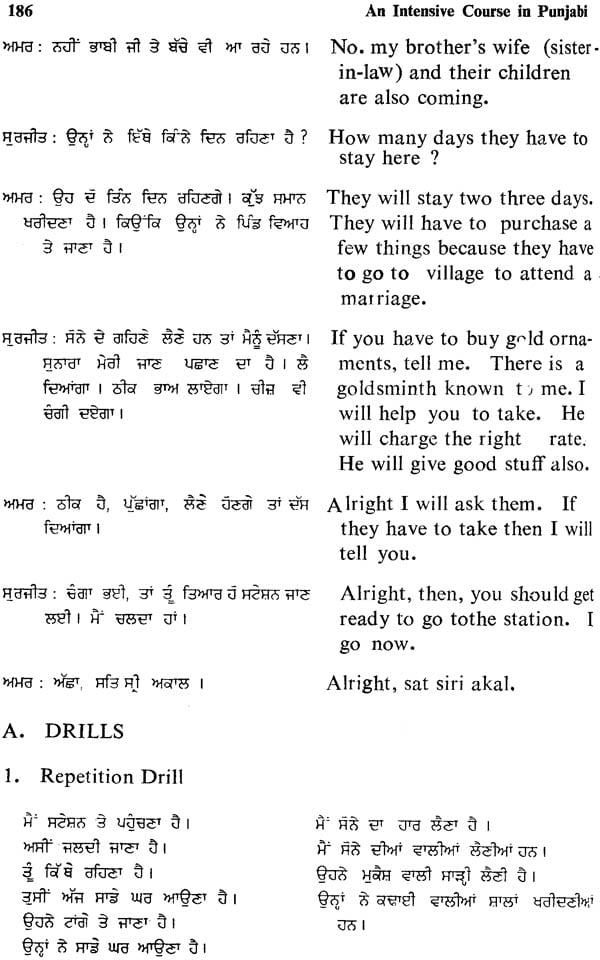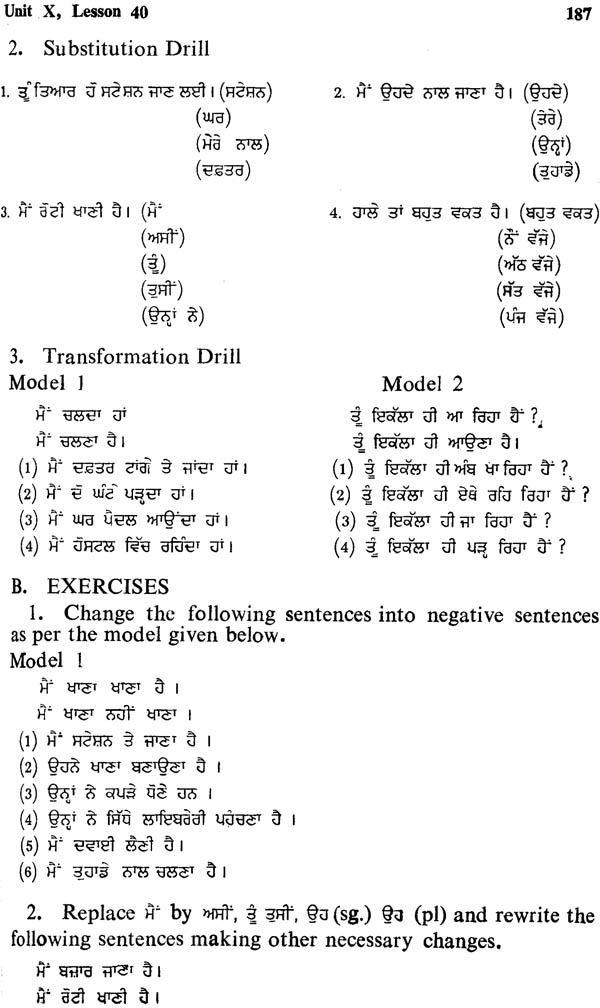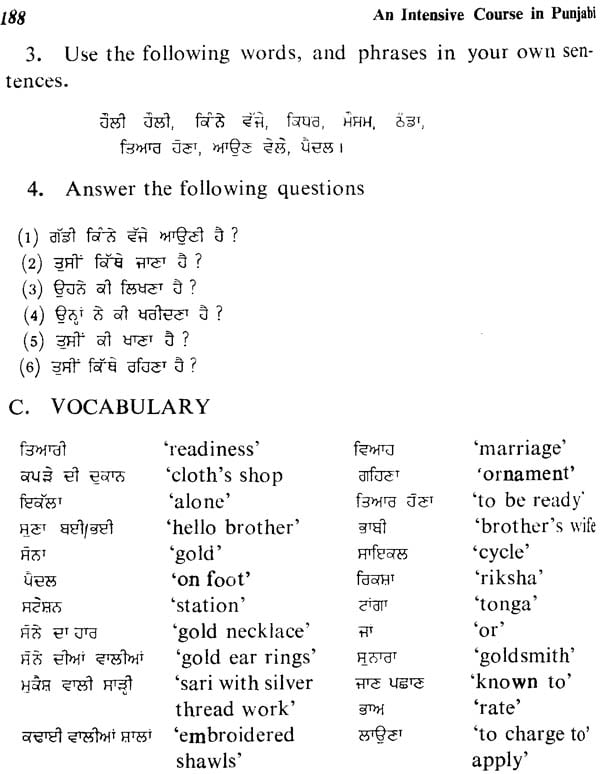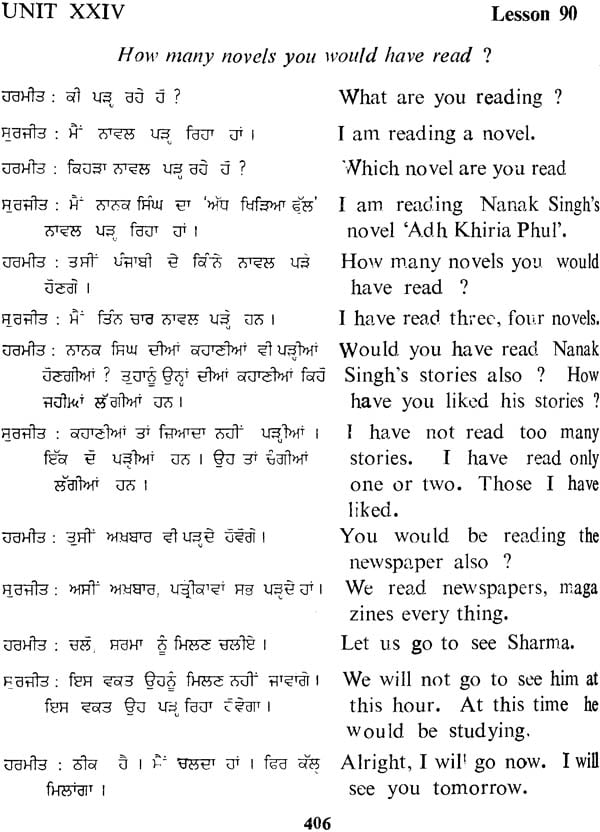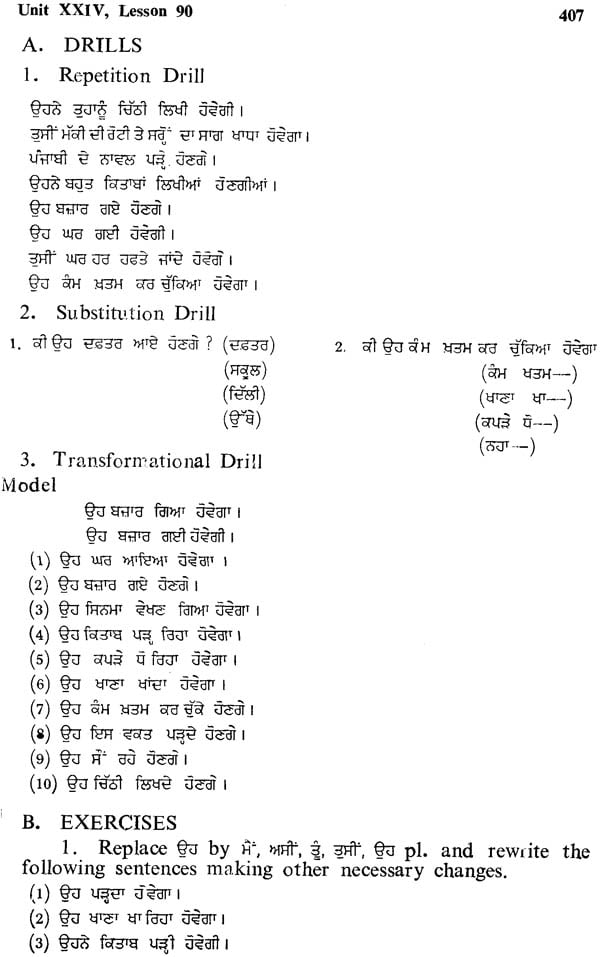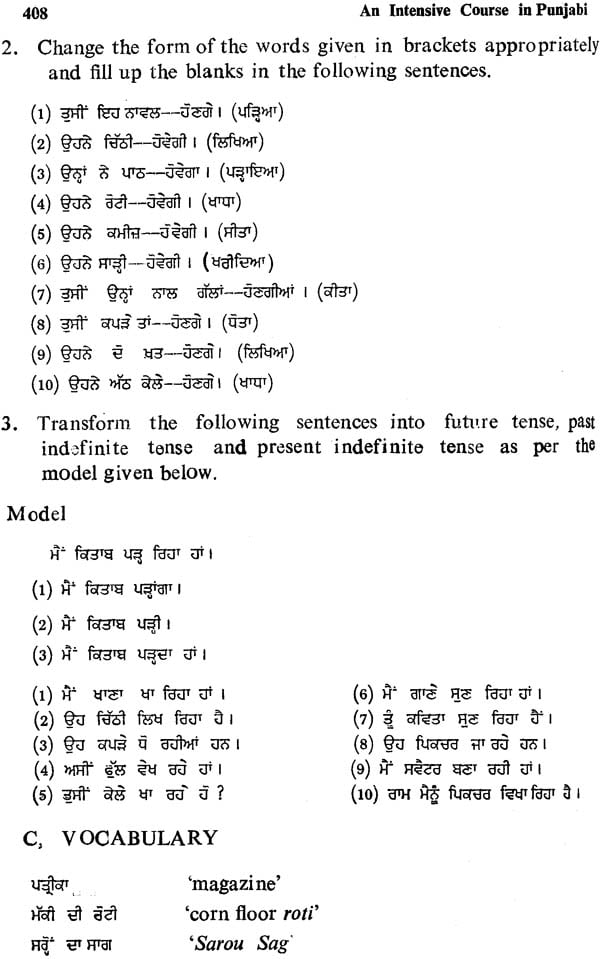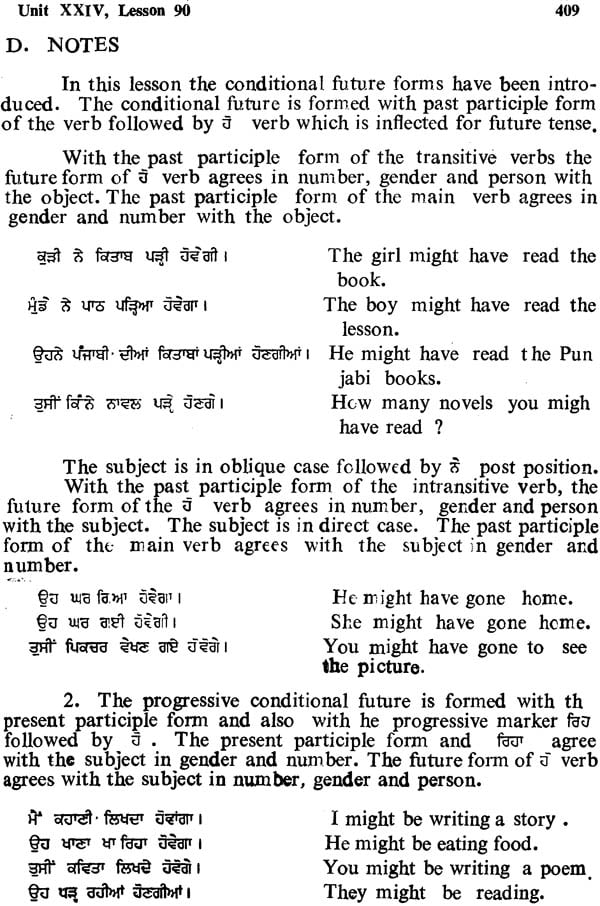
An Intensive Course in Punjabi (An Old and Rare Book)
Book Specification
| Item Code: | NAK110 |
| Author: | Motia Bhatia |
| Publisher: | Central Institute of Indian Languages, Mysore |
| Language: | Punjabi Text With English Translation |
| Edition: | 1985 |
| Pages: | 448 |
| Cover: | Hardcover |
| Other Details | 10.0 inch x 6.5 inch |
| Weight | 670 gm |
Book Description
Language teaching is an ancient profession. India has a long tradition of teaching classical languages following the Gurukula system. The language teaching was not independent of teaching philosophy, logic, grammar and poetics. It addressed itself to a selected group in the society and thus was shaped in methodology and objective by the motivations and purposes of this group.
Language teaching has developed as a sub-discipline within applied linguistics in modern times. All the segments of the society learn languages which may be the mother tongue and/or the second language. The importance of language skills in the educational process, economic activities and cultural assimilation has been recognised. It is a challenge to the linguists to develop models, methods and materials which could meet each and every need of different learners and are suitable to the different learning abilities and aptitudes.
Teaching of Indian languages as a second language to fellow Indians is fast developing as an area demanding immediate attention and work. The Indian languages are taught as a second language under the Three Language Formula in Schools. It is necessary to train teachers to teach the Indian Languages as second language in schools. The Regional Language Centres of second institute cater to this need of man-power development in the area of second language teaching. They offer an intensive course of ten months in a non-native Indian Language to the school teachers. The teaching materials for the courses include conventional as well as audio-visual materials. They were used in the classes for more than a decade and now have been finalized on the basis of experience with various batches of teacher trainess. They are now brought out for wider use. It is hoped that they will be useful for any adult learner of an Indian language.
This book, however, is specifically designed for an Indian adult learner taking into account commonness between Indian languages and share cultural experiences. The course divided into 3 terms has different materials for each term. The first set of materials goes by the name Intensive Course. This Course will be available in 13 major languages of India Viz., Kannada, Tamil, Telugu, Malayalam, Assamese, Bengali, Oriya, Marathi, Gujarati, Sindhi, Punjabi, Urdu and Kashmiri.
The Institute will be happy if these materials contribute to the development of teaching of Indian Languages as second language as a special sub-discipline within language teaching. From the practical point of view, the institute will be happy if these materials help more Indians to become bilingual in other languages of this country.
The acquisition of one's mother togue (MT) is a natural process and an effort of unconscious mind where as the learning of a second/foreign Language is a deliberate attempt with a definite goal in mind. The main difference between the two processes in that while the knowledge of the MT/first language Grows slowly and gradually with the age automatically. A child acquires the language from the environment he is exposed to. The second/foreign language learning is a process of conscious mind. The learner has a particular aim in his mind, definite objective and the expected goal to achieve. Different types of instructional materials and language teaching methods are required to be employed in different types of language teaching and learning situations.
The present intensive Course is intended as a teaching aid for the adult learners of Punjabi who are deputed to learn it at Northern Regional Language Centre of Central Institute of Indian Languages. The course has been properly designed and presented keeping in view the problems and difficulties encountered by the learners and experience gained by teaching Punjabi as a second language.
The lessons have been properly planned and graded. The teaching items including the grammatical structure are graded on the basis of Principle of easy to difficult, simple to complex and known to unknown.
Objectives
The present Intensive Course emphasizes listening speaking, reading and writing skills. The Punjabi phonetic Reader, the Recall Vocabulary in Punjabi (Semantically Classified) and several other reading and writing materials prepared by the Central Institute of Indian Languages for use in the basic course stage may be use I with profit along with this book.
The present book is intended mainly to be used in the basic course stage of the Punjabi Language training programme in the Centre. The entire training programme has the duration of ten months, I. e. about 1100 Clock hours. This period is divided into three stages, namely, basic course, intermediate course and advanced course. The basic course has about 450 clock hours of instruction with primary emphasis on the spoken language. The present Intensive course is she prescribed instructional material for the above mentioned course aiming all the four major skills of language.
The following are the main and sub objective of the basic course in Punjabi offered at the Northern Regional Language Centres. 1 To perceive and reproduce the sounds and meaningful sequences.
Sub – objectives
a) To identify the sounds in their meaningful sequence. b) To discriminate the sounds in their meaningful sequence c) To orally reproduce the sounds in meaningful sequence. 2 To be able to form sentences orally from given patterns and lexical items.
3 To be able to converse with the teacher and with fellow trainees on specified topics under controlled situations.
4 To be able to narrate specified events and topics orally.
5 To be able to read simple and graded passages with comprehension sub-objective:
a) To be able to recognize the letters of the alphabet in isolation and in sequence.
b) To be able to comprehend passages containing simple sentences.
6 To be able to write simple sentences and guided composition on specific topics.
a) To be able to write letters, words and simple sentences.
b) To be able to write guided compositions on specified topics.
It is assumed that the learners have already learnt the Punjabi script before they start this book.
The Central Institute of Indian Languages and the Northern Regional Languages Centre have produced script book, copy book and Panjabi Pustak – I (Sate School Reader, Level I) for this purpose, using the novel method of shape and similarity in letters. It expected that the learners will take 15 to 20 clock hours to learn the Punjabi script. However, the Punjabi alphabet has also been given in this book immediately after the introduction. It is presumed that most of the learners have good back ground in Devanagari script, the transcription of the Punjabi text has also been given in Devanagari in first few lessons to accelerate their reading skill.
After years of experience in the second language teaching the Central Institute of Indian Languages and its Regional Language Centres are convinced that eclectic method of language teaching is the most suitable method for second language teaching.
| Foreword | ||
| Editor's Note | v | |
| Acknowledgement | vii | |
| Introduction | xiii | |
| Punjabi Alphabet | xviii | |
| Unit | lesson | |
| I | 1. What is this? | 1 |
| 2. What are these? | 5 | |
| II | 3. Who is he? | 13 |
| 4. Who are they? | 18 | |
| 5. I am a teacher. | 24 | |
| 6. This is a class of Punjabi. | 29 | |
| 7. A Review lesson. | 35 | |
| III | 8. What is your Name? | 40 |
| 9. Our House | 45 | |
| 10. Where is your father? | 52 | |
| 11. That, the front one, is my house | 58 | |
| 12. He is my grand father | 62 | |
| 13. A Review Lesson | 66 | |
| IV | 14. He is a Good child | 70 |
| 15. How many chairs are these? | 75 | |
| 16. Birthday | 80 | |
| 17. How much it costs? | 85 | |
| V | 18. I was in the hostel | 89 |
| 19. Both were here | 93 | |
| 20. In the hostel | 97 | |
| 21. A Review Lesson | 101 | |
| VI | 22. In the Class Room | 104 |
| 23. Open your books | 108 | |
| 24. He has fever | 114 | |
| VII | 25. What do you study? | 118 |
| 26. I am the eldest | 125 | |
| 27. I used to learn Punjabi | 130 | |
| 28. A Review Lesson | 133 | |
| VIII | 29. Where are you going? | 137 |
| 30. At the Radio Shop | 141 | |
| 31. What were you doing? | 145 | |
| 32. I am reading the first book | 150 | |
| 33. A Review Lesson | 156 | |
| IX | 34. Where will you go? | 160 |
| 35. I will go to the Post office | 165 | |
| 36. Visit to a friend's house | 169 | |
| 37. We will not go | 173 | |
| 38. About a magic show | 177 | |
| 39. A Review Lesson | 182 | |
| X | 40. I have to go to see a movie | 185 |
| 41. We have to go to see a movie | 189 | |
| 42. I had to go | 194 | |
| XI | 43. May we write | 198 |
| 44. Ask him to come here before noon | 204 | |
| 45. About a visit to Anandpur | 209 | |
| XII | 46. Visit to a friend's house | 215 |
| 47. About Kashmir | 220 | |
| 48. How many amongst you are Assamese | 223 | |
| X | 49. About a Sari | 227 |
| 50. How many days it takes from here to your village? | 231 | |
| 51. In a hotel | 235 | |
| 52. A Mango grove | 241 | |
| 53. A Review Lesson | 245 | |
| III | 54. You should work hard | 249 |
| 55. In the canteen | 254 | |
| 56. At the fruit and vegetable shop | 259 | |
| 57. In the tea shop | 263 | |
| 58. A Review Lesson | 268 | |
| XIV | 59. When did you come? | 271 |
| 60. A Review Lesson? | 277 | |
| XV | 61. About a doctor's clinic | 281 |
| 62. I had gone to see a doctor | 286 | |
| 63. About rain | 289 | |
| 64. A talk with a friend | 292 | |
| 65. Enquiring about Railway station | 296 | |
| 66. About watches | 299 | |
| 67. A Review Lesson | 305 | |
| XVI | 68. Darbar Sahib | 309 |
| 69. About a house | 313 | |
| XVII | 70. Buying a Sweater | 319 |
| XVIII | 71. A Conversation between friends | 323 |
| 72. Orange Vendor | 328 | |
| XIX | 73. Mr. Sinha | 331 |
| 74. Do you like this? | 336 | |
| XX | 75. What are you reading while eating? | 340 |
| 76. Invitation for Dinner | 344 | |
| 77. I have been here since last eight months | 349 | |
| 78. A Review Lesson | 355 | |
| XXI | 79. Talk about study | 358 |
| 80. I have to walk | 362 | |
| 81. In the market | 367 | |
| 82. At the Bus Stand | 371 | |
| XXII | 83. Why are you reading a book while eating | 375 |
| 84. I am preparing the broken chair | 378 | |
| 85. A Review Lesson | 382 | |
| XXIII | 86. Visit to a friend | 385 |
| 87. Coffee or Tea | 490 | |
| 88. How big is this bag? | 396 | |
| 89. A Review lesson | 402 | |
| XXIV | 90. How many novels you would have read? | 406 |
| Word Index | 410 |
